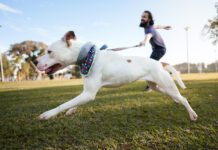The end of the year always seems to come too fast. Im way behind schedule and have too much to do. Im lucky in one respect, however. Lately, Ive been buried in excellent articles contributed by some of WDJs most passionate and informed expert/writers. The next year will offer a treasure trove of articles on hot topics, including heartworm prevention and treatment, helping re-homed dogs adjust, alternative treatments for cancer, puppy training, and more.
Unfortunately, I have a ton of homework to do! Im still buried in research for our annual frozen, canned, and dry food reviews, and drowning in terrific products many of them suggestions from our readers to introduce in our annual installment of Gear of the Year. I promise Ill catch up, and all of these articles will appear soon!
This issue is full of fascinating information. Longtime contributor CJ Puotinen, who lives in New York, near the front lines of the canine flu, starts us off with a timely list of practical methods for keeping your dog protected from viral infections. I dont know how she found the time to write this while researching and writing her in-depth series on canine cancer; the second installment, on conventional and cutting-edge medical treatments, is in this issue.
Also in this issue, Santa Cruz trainer Mardi Richmond explains how to enjoyably teach our dogs a reliable recall. My Chihuahua has a good recall laboriously cultivated over the first six months I had him but Mardis article was a good review. Like many owners, I dont work as consistently as I should to preserve this skill.
Our Training Editor, Maryland resident Pat Miller, offers another illuminating lesson on canine body language, and a review of her favorite positive training books of all time.
Finally, Shannon Wilkinson writes from Seattle about the controversy over docking tails, cropping ears, and removing dewclaws. I was familiar with the objections to cosmetic surgery on dogs ears and tails, but the arguments against removing dewclaws were new (and persuasive) to me. (And I speak as someone who recently paid for a visit to the vet after Mokie halfway broke off one of his dewclaws right at its nerve-filled base.) Dewclaws can be a pain, literally, but Im convinced that on most dogs, they are there for a reason.
———-
The Rabies Challenge Fund
Im hoping that WDJ readers will throw their generous support behind the following project:
World-renown vaccine research scientist, W. Jean Dodds, DVM, and pet vaccine disclosure advocate, Kris L. Christine of Maine, have established The Rabies Challenge Fund to raise money to fund a seven-year rabies vaccine challenge study in the United States.
In addition to the challenge study, the fund will finance a study of the adjuvants used in veterinary rabies vaccines and establish a rabies vaccine adverse reaction reporting system.
Researchers believe the rabies vaccine causes the most and worst adverse reactions in animals. The Rabies Challenge Fund has been founded to improve the safety of rabies vaccines and to determine, by challenge, if they confer immunity for five, six, or seven years.
Despite overwhelming moral support from pet owners, only a trickle of financial donations has been received.
Lets get this thing funded so the work can start. Could your training club sponsor a dog wash, with the proceeds going to the Fund? Could you ask every one of your dog-owning friends and relatives for a dollar apiece for a great cause? Can you think of better ways to raise money, and send them to me?
Donations can be sent to:
The Rabies Challenge Fund
c/o Hemopet, 11330 Markon Dr.
Garden Grove, CA 92841
———-
Correction
In How to Choose a Food, which was published in our July issue, we stated that Science Diets Natures Best dog food contains artificial colors. That statement was incorrect; the food is colored with a natural substance. We regret the error.
-Nancy Kerns





